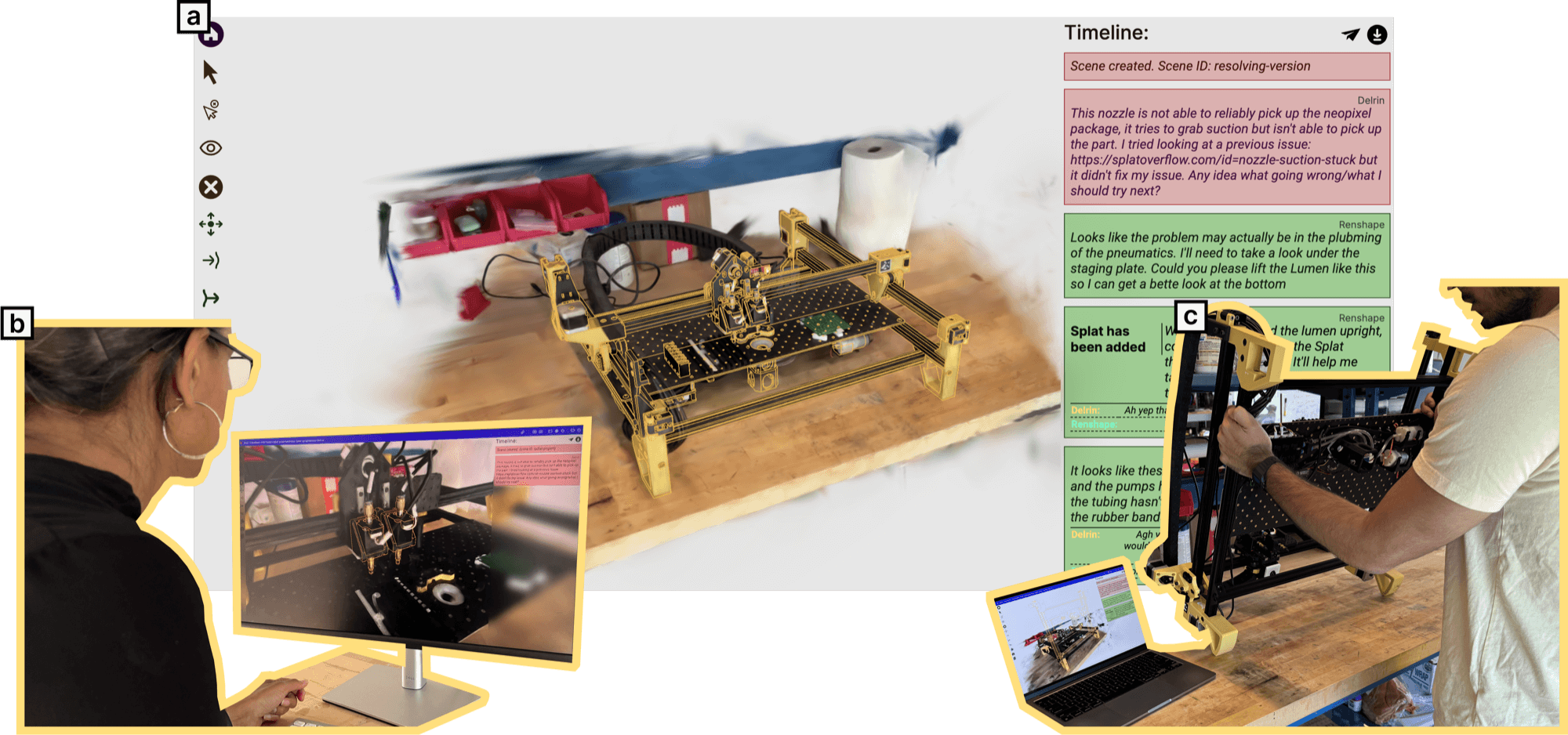SplatOverflow: Asynchronous Hardware Troubleshooting
, Cornell Tech, Cornell University
To Appear in Proceedings of the 2025 ACM Computer-Human Interaction Conference (CHI’25)
Honorable Mention for Best Paper
 Figure 1. (a) A SplatOverflow scene, comprising a 3D Gaussian Splat aligned and registered onto a digital CAD model, acting as a boundary object to facilitate asynchronous troubleshooting tasks for hardware. A local end-user can query technical documentation and past issues associated with the hardware by simply clicking on the parts in the SplatOverflow scene. If no solution is found, they can use SplatOverflow to request and receive help asynchronously from a remote maintainer. (b) A remote maintainer uses SplatOverflow to explore a local end-user's hardware and author instructions for them to follow. (c) A local end-user views the maintainer's instructions rendered as an overlay onto their hardware in their workspace and executes the specified action.
Figure 1. (a) A SplatOverflow scene, comprising a 3D Gaussian Splat aligned and registered onto a digital CAD model, acting as a boundary object to facilitate asynchronous troubleshooting tasks for hardware. A local end-user can query technical documentation and past issues associated with the hardware by simply clicking on the parts in the SplatOverflow scene. If no solution is found, they can use SplatOverflow to request and receive help asynchronously from a remote maintainer. (b) A remote maintainer uses SplatOverflow to explore a local end-user's hardware and author instructions for them to follow. (c) A local end-user views the maintainer's instructions rendered as an overlay onto their hardware in their workspace and executes the specified action.
Abstract
Compared to the plethora of software tools that support designing hardware, there are relatively few tools that support troubleshooting and maintaining hardware. As a result, providing technical support for hardware is often ad-hoc and challenging to scale. Inspired by software troubleshooting workflows (like those enabled by StackOverflow) we propose a workflow for asynchronous hardware troubleshooting: SplatOverflow. SplatOverflow creates a novel boundary object that scaffolds asynchronous communication about hardware between multiple users. A SplatOverflow scene comprises a 3D Gaussian Splat 3D Gaussian Splatting [Kerbl et al. 2023] is a view-interpolation and rasterization technique that renders a 3D scene as a collection of Gaussian distributions. of the end-user's hardware registered onto the hardware's CAD model. These two elements enable multiple users to remotely and independently inspect an end-user's hardware instance, easily compare the hardware instance to it's design or associated documentation, and communicate actions or instructions the end-user must carry out. SplatOverflow links these comments, instructions and discussions to the CAD parts they reference and stores them for future users to easily query and access. Similar to StackOverflow, this allows communities of users to build pools of shared technical knowledge about the hardware they are all using. In the paper accompanying this project, we describe the design of SplatOverflow, detail the workflows it enables, and explain its utility to different kinds of users. We also validate that non-experts can use SplatOverflow to troubleshoot common problems with a 3D printer in a user study.
Demonstrative Examples
We demonstrate SplatOverflow with a variety of hardware examples, including a pick-and-place machine (the LumenPnP v3 by Opulo), a 3D printer (the Prusa MK3S+ by Prusa Research), and an open-source e-reader (The Open Book by Oddly Specific Objects).
 Figure 4. A still of a SplatOverflow scene depicting the PCB for an open-source e-reader, the Open Book registered onto it's CAD model. In (a) electrical traces from the PCB layout are overlaid onto the board as a yellow wireframe. In (b) electrical pads are highlighted.
Figure 4. A still of a SplatOverflow scene depicting the PCB for an open-source e-reader, the Open Book registered onto it's CAD model. In (a) electrical traces from the PCB layout are overlaid onto the board as a yellow wireframe. In (b) electrical pads are highlighted.
Source Code & Documentation
The source code and accompanying technical documentation of our implementation will be available shortly under a
CC BY-SA
license. If you'd like access before the public release, please reach out using the email address below.
BibTex
@inproceedings{kwatra2024splatoverflow,
author = {Kwatra, Amritansh and Weinberg, Tobias M and Mandel, Ilan and Batra, Ritik and He, Peter and Guimbretiere, Francois and Roumen, Thijs},
title = {SplatOverflow: Asynchronous Hardware Troubleshooting},
year = {2025},
isbn = {9798400713941},
publisher = {Association for Computing Machinery},
address = {New York, NY, USA},
url = {https://doi.org/10.1145/3706598.3714129},
doi = {10.1145/3706598.3714129},
booktitle = {Proceedings of the 2025 CHI Conference on Human Factors in Computing Systems},
articleno = {450},
numpages = {16},
keywords = {Hardware Maintenance, Repair, Troubleshooting},
series = {CHI '25}
}
Acknowledgements
We would like to thank the Digital Life Initiative at Cornell Tech for supporting this work through a doctoral fellowship. We would also like to thank Joey Castillo, Frank Bu and Stephen Hawes for taking part in preliminary discussions that helped motivate this work.
This page was created using the open-source Tufte Project Pages template.
Contact
If you have questions about this work, contact Amrit Kwatra:
tansh at amritkwatra dot com
.